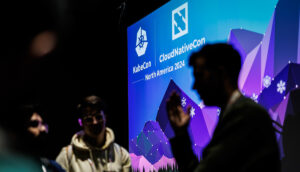SiliconANGLE article by Jason English
 Artificial intelligence was on the tip of everyone’s tongue, as expected, at the start of last week’s KubeCon/CloudNativeCon North America 2024 in Salt Lake City, until it wasn’t.
Artificial intelligence was on the tip of everyone’s tongue, as expected, at the start of last week’s KubeCon/CloudNativeCon North America 2024 in Salt Lake City, until it wasn’t.
If anything, the latest flavors of generative AI and agentic AI are merely driving higher future scalability and stability expectations from Kubernetes-based and related cloud-native applications running almost everywhere, and the open-source projects and vendors that support them.
With Kubernetes turning 10 years old, we looked back at the early days when “most of the wires were left hanging” for later innovation by the community. Today there are 65 graduated or incubated open-source projects within the Cloud Native Computing Foundation ecosystem, with dozens more supported by thousands of expert contributors from large enterprises and fresh startups dealing with practical concerns of interoperability and integration, data movement and storage, and cybersecurity and governance.
Enterprise-scale needs are constantly evolving, and this community is rising to the challenge of serving developers in scaling and deploying cloud native applications, with new cost efficiency, networking, orchestration methods, composition and security capabilities.
As trillions of dollars worth of innovation work is already invested in open source projects, patent trolls are starting to rear their ugly heads and litigate license fees and fines from enterprises using the technology. To fight back, the CNCF recently joined the Open Source Zone, announcing a Prior Art bounty challenge where developers can provide proofs of work that predate such claims and crush the offending patents inside the USPTO.
Since this is my sixth KubeCon NA, I tried to visit only the most interesting vendors in the showcase, which was no small task, given the breakneck pace of innovation on display. Here are a few highlights:
Interoperability and integration
The cloud-native paradigm was never just about moving applications to a particular public cloud hyperscaler; it has always been about running and scaling workloads wherever they make the most sense for end customer and user requirements. This year, vendors were serious about supporting this “run anywhere” approach so critical workloads could run in any public cloud, on-prem or on the edge in devices and remote networks.
Also, while platform engineering is no longer as buzzworthy as it was in years past, improving developer and operator experience with well-organized, well-maintained resources has advanced well beyond the self-service portal to incorporate easy low-code workflows and AI-based curation and advice.
On this topic, Diagrid had a festive presence at Kubecon, celebrating the graduation of the Dapr distributed application runtime project with built-in workflow, task chaining, a pub/sub message broker, state and session handling, observability and secure cryptography. Platform engineers can engage further with its Conductor management and analytics platform and its Catalyst SaaS or on-premises supported deployment services.
Mirantis was there, introducing …
Read the full event perspective on SiliconANGLE here: https://siliconangle.com/2024/11/19/kubecon-cloudnativecon-2024-ai-hype-gives-way-real-application-concerns/.
Jason English is partner and principal analyst at Intellyx. He wrote this article for SiliconANGLE. Intellyx B.V. Chronosphere, Cloud Foundry Foundation, and Mezmo are Intellyx customers. Jason English is an advisor to Speedscale. Picture: CNCF / Flickr.



